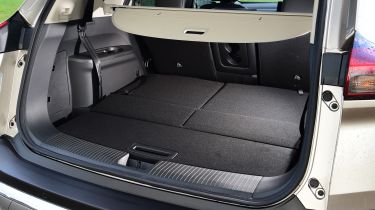Nissan X-Trail review - Practicality, comfort and boot space
Interior space is good, but the X-Trail’s boot isn’t as big as some rivals
Buyers will be impressed by the X-Trail’s refinement on the road. It’s a comfortable and relaxing place in which to travel, while Nissan hasn’t forgotten the practical touches which make family life a little easier. Items such as a centre armrest with two cup holders, luggage hooks and lighting in the boot, 60/40 split-folding rear seats and two rear Isofix points all add to the X-Trail’s ease of use.
We found that the smartphone charging shelf is big enough for even the largest devices, but the glovebox isn’t particularly roomy. Meanwhile the door bins are a decent size, but they lack any kind of carpeted inserts that could stop items rattling around when you're driving.
Moving up through the various trim levels brings more luxury kit such as a heating function for the front and rear seats, steering wheel and windscreen, plus wireless smartphone charging, tri-zone air-conditioning and quilted leather upholstery. It's also worth noting that the X-Trail is offered in both five- and seven-seater configurations.
Size
At 4,760mm long, the X-Trail is slightly longer than a Skoda Kodiaq and a Peugeot 5008. The fourth-generation model is 20mm wider and 15mm taller than its predecessor, which gives it an even more substantial look on the road.
Leg room, head room & passenger space
Room up front is good and what you’d expect from a large SUV. The X-Trail feels more spacious than a Qashqai, with rear passengers benefitting from lots of legroom and headroom. We also like how the centre seat in the X-Trail's middle bench folds down entirely to provide a huge armrest for rear passengers.
More reviews
Car group tests
In-depth reviews
Road tests
- New Nissan X-Trail N-Trek e-Power 2024 review: functional rather than thrilling
- New Nissan X-Trail 2022 review
- New Nissan X-Trail 2017 facelift review
- Nissan X-Trail 2.0 diesel 2017 review
- Nissan X-Trail 1.6 DIG-T review
Used car tests
If you do decide to order your X-Trail with seven seats like our test, only kids will really feel comfortable in the back row. The first issue is that the middle-row seats don’t move very far out of the way, so you need to wriggle through a small gap to access the third row’s small, firm seats – and they have limited knee and headroom. The Nissan is fine for occasional use, but it isn’t a full-time seven-seater, and the Kia Sorento (which comes as standard with seven seats) will feel more spacious with seven people on board.
Boot
The X-Trail’s boot isn’t the largest in its class. In the mild-hybrid model you get 585 litres of luggage space (with rear seats in an upright position) which is 81 litres more than you’ll find in the Nissan Qashqai. The e-Power versions offer 575 litres, while there’s a further reduction to 485 litres in overall carrying capacity if you go for a seven-seat model. Folding the rear seats unlocks a more useful load space of around 1,300 to 1,400 litres, again depending on which powertrain you go for.
Towing
If you’re prioritising towing ability then you’ll want to avoid the 201bhp e-Power version because it has a 670kg maximum braked trailer weight. The 161bhp mild-hybrid model has a 2,000kg limit in five-seat guise, which is reduced to 1,800kg if you opt for a seven-seater variant. The top-of-the-range 210bhp e-4orce is capable of pulling up to 1,800kg, although its overall capacity is reduced to 1,650kg when configured as a seven-seat model.






